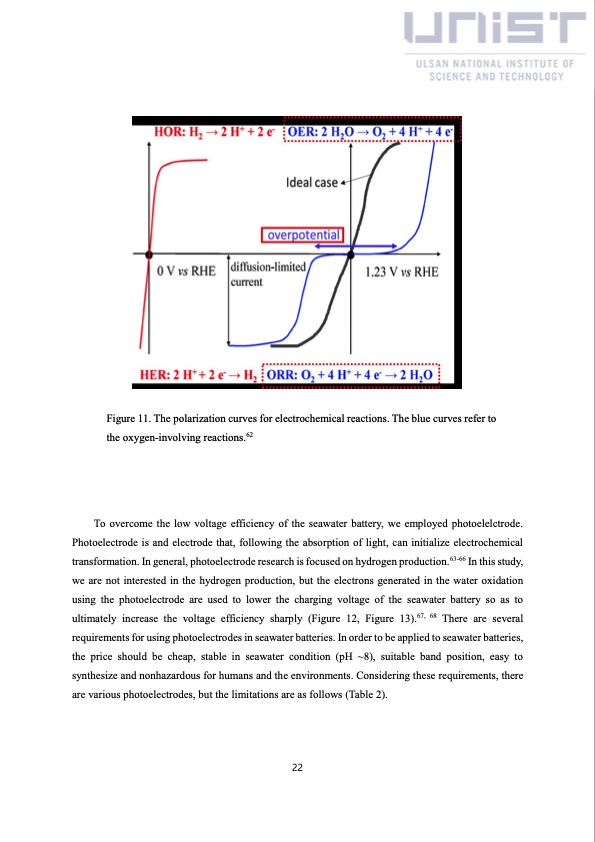
PDF Publication Title:
Text from PDF Page: 027
Figure 11. The polarization curves for electrochemical reactions. The blue curves refer to the oxygen-involving reactions.62 To overcome the low voltage efficiency of the seawater battery, we employed photoelelctrode. Photoelectrode is and electrode that, following the absorption of light, can initialize electrochemical transformation. In general, photoelectrode research is focused on hydrogen production.63-66 In this study, we are not interested in the hydrogen production, but the electrons generated in the water oxidation using the photoelectrode are used to lower the charging voltage of the seawater battery so as to ultimately increase the voltage efficiency sharply (Figure 12, Figure 13).67, 68 There are several requirements for using photoelectrodes in seawater batteries. In order to be applied to seawater batteries, the price should be cheap, stable in seawater condition (pH ~8), suitable band position, easy to synthesize and nonhazardous for humans and the environments. Considering these requirements, there are various photoelectrodes, but the limitations are as follows (Table 2). 22PDF Image | China solar seawater battery

PDF Search Title:
China solar seawater batteryOriginal File Name Searched:
solar-seawater.pdfDIY PDF Search: Google It | Yahoo | Bing
Product and Development Focus for Salgenx
Redox Flow Battery Technology: With the advent of the new USA tax credits for producing and selling batteries ($35/kW) we are focussing on a simple flow battery using shipping containers as the modular electrolyte storage units with tax credits up to $140,000 per system. Our main focus is on the salt battery. This battery can be used for both thermal and electrical storage applications. We call it the Cogeneration Battery or Cogen Battery. One project is converting salt (brine) based water conditioners to simultaneously produce power. In addition, there are many opportunities to extract Lithium from brine (salt lakes, groundwater, and producer water).Salt water or brine are huge sources for lithium. Most of the worlds lithium is acquired from a brine source. It's even in seawater in a low concentration. Brine is also a byproduct of huge powerplants, which can now use that as an electrolyte and a huge flow battery (which allows storage at the source).We welcome any business and equipment inquiries, as well as licensing our flow battery manufacturing.| CONTACT TEL: 608-238-6001 Email: greg@salgenx.com | RSS | AMP |